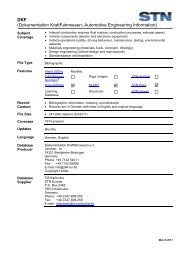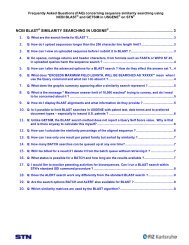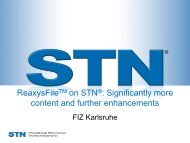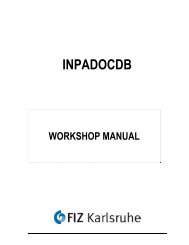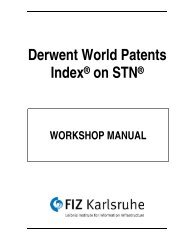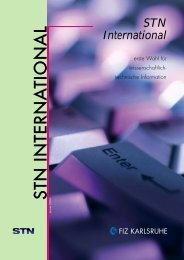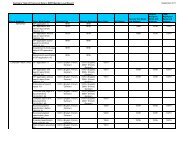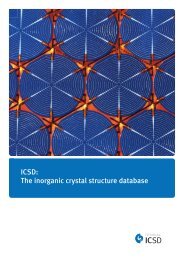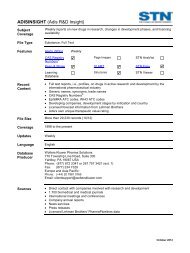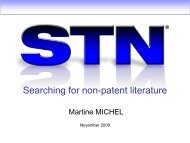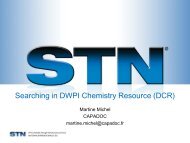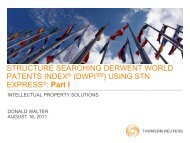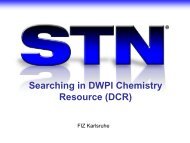note - FIZ Karlsruhe
note - FIZ Karlsruhe
note - FIZ Karlsruhe
Create successful ePaper yourself
Turn your PDF publications into a flip-book with our unique Google optimized e-Paper software.
Sequence Code Match Searching<br />
L2 ANSWER 1 OF 1 DGENE COPYRIGHT 2010 THOMSON REUTERS on STN<br />
ACCESSION NUMBER: AAW83315 peptide DGENE Full-text<br />
TITLE: New isolated LDL-receptor related protein - used to develop<br />
products for treating, e.g. elevated triglyceride levels,<br />
diabetes, autoimmune disorders, inflammation or Alzheimer's<br />
disease<br />
INVENTOR: Caskey C T; Cox R D; Gerhold D; Hammond H; Hess J W; Hey P;<br />
Kawaguchi Y; Merriman T R; Metzker M L; Nakagawa Y; Phillips<br />
M S; Todd J A; Twells R C J<br />
PATENT ASSIGNEE: (MERI)MERCK & CO INC.<br />
(WELL) WELLCOME TRUST LTD.<br />
PATENT INFO: WO 9846743 A1 19981022 200<br />
APPLICATION INFO: WO 1998-GB1102 19980415<br />
PRIORITY INFO: US 1997-48740 19970605<br />
US 1997-43553 19970415<br />
PAT. SEQ. LOC: Claim 20; Page 126<br />
DATA ENTRY DATE: 10 FEB 1999 (first entry)<br />
DOCUMENT TYPE: Patent<br />
LANGUAGE: English<br />
OTHER SOURCE: 1998-594573 [50]<br />
DESCRIPTION: LRP5 protein fragment #3.<br />
KEYWORD: LRP5; LDL-receptor related protein; LRP-3; IDDM; diagnosis;<br />
endocytosis; insulin dependent diabetes mellitus; autoimmune<br />
disease; glomerulonephritis; inflammation; viral infection;<br />
osteoporosis; hypercholesterolemia; Alzheimer's disease; low<br />
density lipoprotein.<br />
ORGANISM: Homo sapiens.<br />
ABSTRACT:<br />
The present invention describes LRP5 (low density lipoprotein (LDL)<br />
receptor related protein, previously designated LRP-3). The present<br />
sequence represents a specifically claimed LRP5 protein fragment. Nucleic<br />
acid molecules (NAMs) encoding LRP5 can be used for determining if an<br />
individual is susceptible to insulin dependent diabetes mellitus (IDDM).<br />
The NAMs or proteins can be used for reducing triglyceride levels in the<br />
serum of an individual. Therapies that affect LRP5 may also be useful in<br />
the treatment of autoimmune diseases such as glomerulonephritis, diseases<br />
and disorders involving disruption of endocytosis and/or antigen<br />
presentation, cytokine clearance and/or inflammation, viral infection,<br />
pathogenic bacterial toxin contamination, elevation of free fatty acids<br />
or hypercholesterolemia, type 2 diabetes, osteoporosis, Alzheimer's<br />
disease and cardiovascular disease. Products from the present invention<br />
can also be used for detection, diagnosis and drug screening.<br />
AMINO ACID COUNTS: 1 A; 1 R; 1 N; 1 D; 0 B; 0 C; 0 Q; 1 E; 0 Z; 1 G;<br />
0 H; 1 I; 3 L; 0 K; 0 M; 1 F; 1 P; 0 S; 2 T; 0 W; 0<br />
Y; 4 V; 0 Others<br />
SEQUENCE LENGTH: 18<br />
SEQUENCE<br />
1 evlfttglir pvalvvdn<br />
========== ========<br />
HITS AT: 1-18<br />
The retrieved answer differs from the query by two amino acids:<br />
Page 108 | GENESEQ on STN (DGENE) Workshop Manual<br />
Query: D V L F T T G L I R P V A L V V D Q<br />
Answer: E V L F T T G L I R P V A L V V D N<br />
D (aspartic acid) has been matched with E (glutamic acid)<br />
Q (glutamine) has been matched with N (asparagine)



